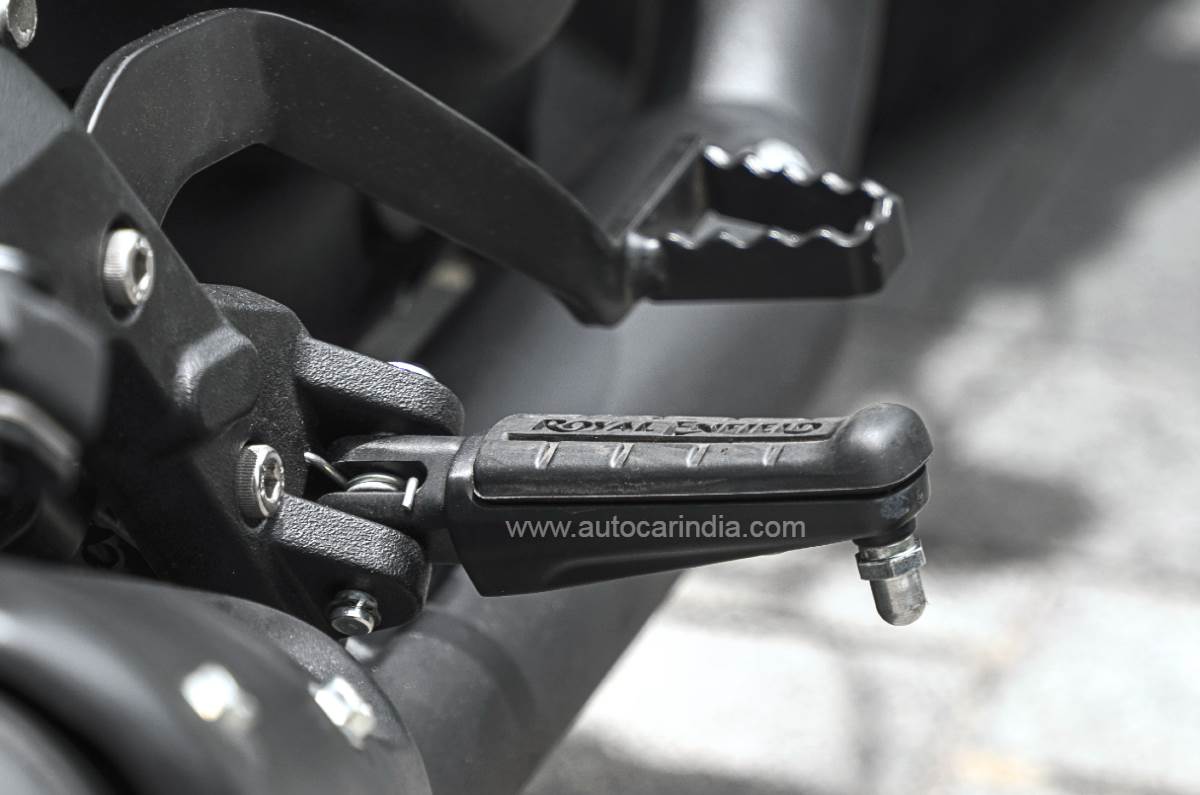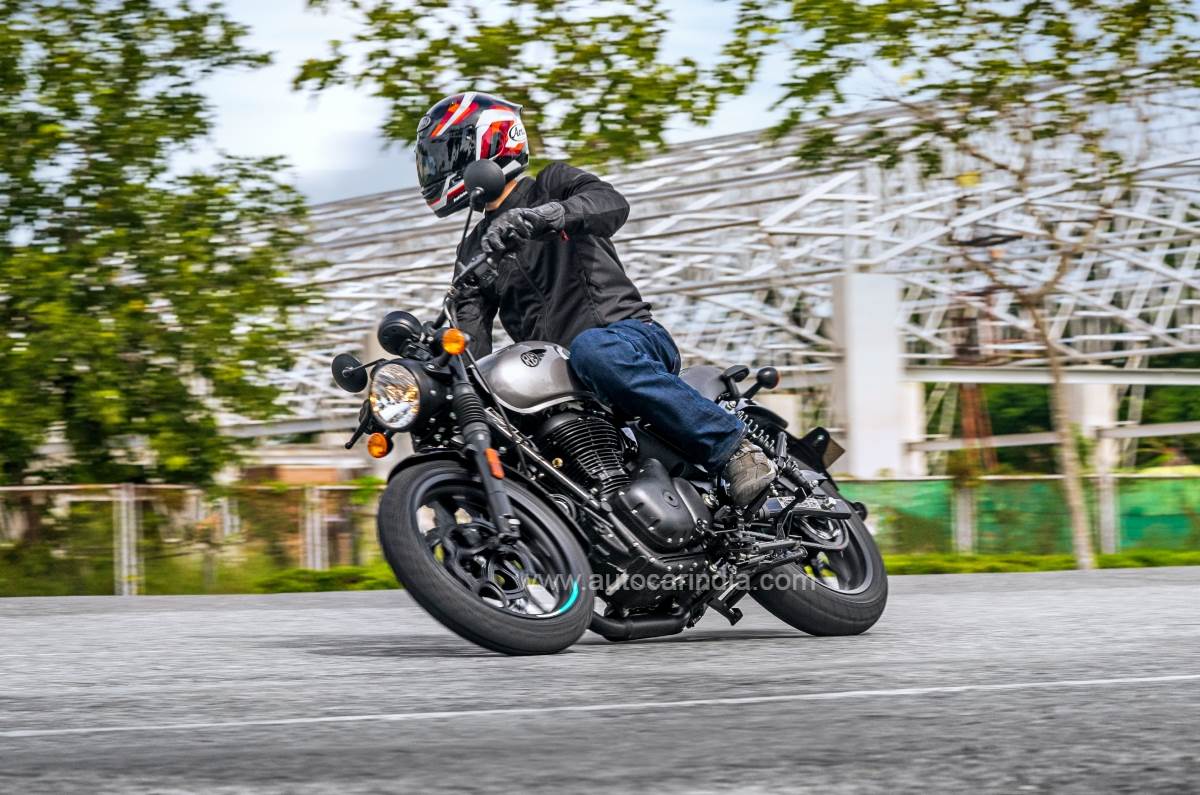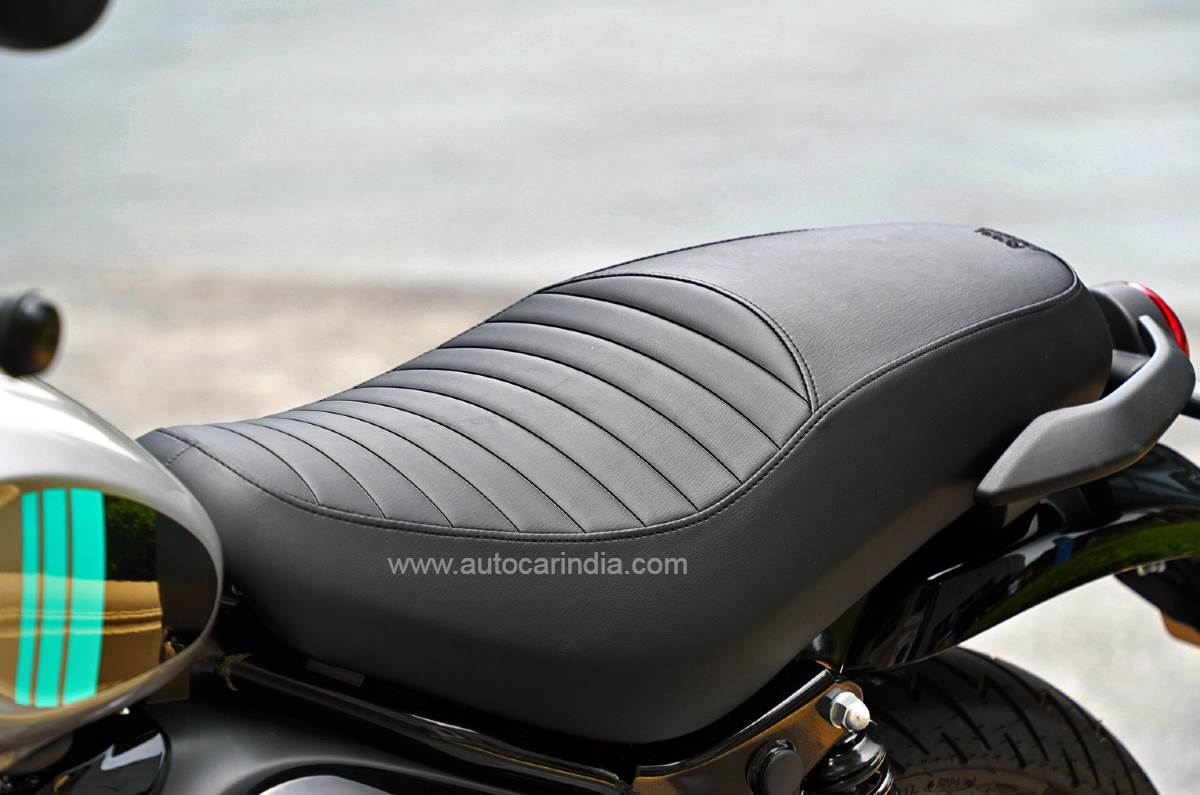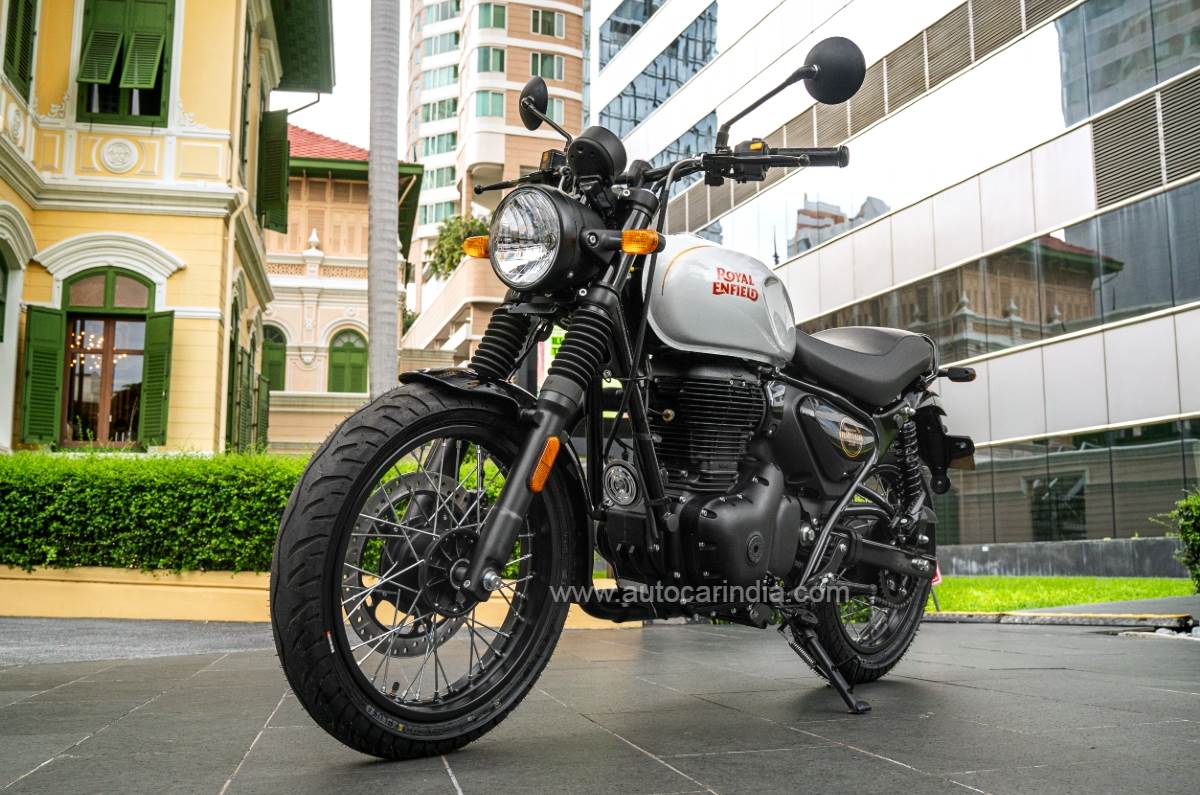Armed with an aggressive price tag, this new Royal Enfield offering is a more contemporary bike than what we’re used to seeing from the brand.
It’s been two years since the debut of the new Royal Enfield J platform of 350cc motorcycles and the company says they have already made over half a million of these bikes. Clearly, existing customers have accepted the J platform bikes with open arms, but the new age Classic 350 and Meteor 350 are very much ‘Royal Enfield’ sort of bikes. With this new Hunter 350, the company is now trying to broaden out to a newer, wider customer base.
The whole idea is to make this bike more accessible, be it to non-RE fans or just newer riders in general. Effectively, this is a smaller, lighter, easier and more contemporary bike than what we’re used to seeing from Royal Enfield.
Royal Enfield Hunter 350: riding ease and capability
There are a few figures that matter when it comes to ease and accessibility. The first is the seat height and with an 800mm tall seat (as well as a narrow section where the seat meets the fuel tank), the Hunter is welcoming for shorter riders. On the other hand, I’m 6’1” and I also fit comfortably on the bike.
Then there’s the weight and at 181kg, this bike is 14 kilos lighter than the Classic 350 – but that’s on paper and when you ride the bike it feels even lighter than that. That’s because the Hunter has some pretty significant changes going on with the chassis. This is the first modern RE with 17-inch wheels at both ends, and that alone brings in a lot more agility. In addition, the wheelbase is 20mm shorter than the Classic and the steering rake angle is now sharpened to 25 degrees, which is quite aggressive for a 350cc Royal Enfield.
The base platform is the same as on the Classic and Meteor and the front section of the chassis is the same on all three bikes. However, the rear of the frame is now a little shorter and there’s a new sub frame. It also doesn’t have the heavy, metal footpeg cradle underneath that usually holds the forward-set pegs you get on the Meteor and Classic.
The seat is set at 790mm and the bike weighs in at 181kg.
The result is a bike that rides and handles almost like a typical 250cc naked bike. It’s strange at first to feel that torquey, slow-revving engine matched to such a light and agile feeling motorcycle, but it’s something you quickly get used to. We rode through all sorts of Bangkok roads, from jammed rush hour traffic to beautifully fast and open highways. The company even let us have a few laps around a go-kart track where the bike was a whole lot of fun.
The Hunter has one degree more of available lean angle at each side (43 degrees left and 42 degrees right) compared with the Meteor, which is nice, but you still don’t have to try too hard before the footpegs start scraping. For most real world situations though, there’s plenty of lean angle available. This bike is also willing to change direction much faster, and with considerably less effort than any modern day Enfield. That makes it good fun, whether you’re fooling around on a go-kart track or just navigating through traffic.
The new Ceat tyres are perfectly good for this application as well. Braking-wise, the Hunter has a new front master cylinder which gives it a little more feel and progression, but the rest of the set-up is the same as the Classic and Meteor. And like its siblings, these brakes need a strong pull at the lever for urgent stops. The top Hunter Metro variant we’re riding has dual channel ABS as standard.
As for suspension comfort, it’s hard to tell how the Hunter will do because Thailand has some beautiful roads that sort of put ours to shame. However, this suspension is a little more firm than either the Classic or the Meteor, especially at the rear. From what we could tell, this bike will feel more firm than its siblings, but I don’t think it will get to the point of being too much. Still, that will have to wait till we ride it on bad roads. The Hunter is also down on ground clearance compared to the Classic, but I don’t think the 150mm figure will be a serious problem, considering the firm rear shocks and the shorter wheelbase.

Footpegs are more rear set than its 350 siblings.
The riding position is comfortable, and it reminds me of the Interceptor 650 because the footpegs are now underneath you, rather than in front. Like the Interceptor, there’s a slight stretch forward to the handlebar and the footpegs are slightly rear-set. It is a much more connected riding position than the other 350s, and that will appeal to many people.
Royal Enfield Hunter 350: engine, performance
Overall, the chassis is nimble and playful, but I wouldn’t go so far as to call this a sporty motorcycle – fun yes, but not sporty. And the primary reason behind that is the engine, which is pretty much exactly the same as what’s in the Classic and the Meteor.
While the power and torque figures are exactly the same (20hp and 27Nm), RE says they have mapped the engine slightly differently. They’ve already managed to make the Classic and Meteor engine feel a little different to each other by doing this, and the same applies to the Hunter. This motor feels a little more responsive and the sound from the shorter exhaust is a little more raspy.
Nevertheless, this is still a very similar riding experience, and RE says you can expect similar performance as well as fuel efficiency, which is a claimed 36.2kpl.

The Hunter 350 comes across as a fun motorcycle.
On the highway, the Hunter feels wonderful at about 80kph and it can hold a 100 without stress. Anything above that comes quite slowly, but even at its top speed of about 120kph, the engine feels smooth enough and without any significant vibration.
That sort of performance is nothing special – and if you care about 0-100 times and top speeds, you should look elsewhere. But if you savour riding at a calm and gentle pace, this is one of the most characterful and enjoyable engines that you will find on any Indian motorcycle. Just like the Classic and Meteor, it’s all about relishing the strong low- and mid- range torques along with the gentle beat that can be felt from the engine through the whole motorcycle. I’ve really been enjoying commuting on our long term Classic 350 and this lighter Hunter should be no less enjoyable while being easier to manage. The only issue is that just like its siblings, the Hunter has a heavy clutch, and that does get tiring when you invariably get stuck in a traffic jam.
Royal Enfield Hunter 350: design and features
The Hunter is a cheerful bike to ride and I think it also looks quite nice. The challenge with the typical modern retro roadster design is that you can’t do much with the overall silhouette and you’ve got to have the standard stuff like a round headlamp, teardrop shaped tank, small side panel. But Royal Enfield has managed to give this bike some of its own identity without doing things that come across as weird or forced. You can see that in the unusually shaped knee recesses and the unique side panels as well as the neatly done rear. There’s a whole bunch of well-designed accessories, and I find that the flat seat along with the optional tail tidy help elevate this design.
This most certainly is a more compact bike by RE standards and it’s dimensionally smaller than the Classic in every way. But it is still a 180-kilo machine, so it’s not outright small either and it even fits a pillion rider quite comfortably.
The Hunter has a nice set of proportions even though it’s running on smaller 17-inch wheels, but I think the colour pattern plays a significant role. I like the Dapper Ash colour scheme on our bike because it lets you appreciate the lines on the tank better – some of the other schemes on the Metro models have quite a bit of bold lettering that is a bit distracting to my eyes. In fact, the lower Retro model has much simpler, cleaner looking paint schemes.
Retro variants get wire spoke wheels, a simpler instrument cluster and single-channel ABS with a rear drum brake.
Features wise, the Hunter keeps it simple with no fancy toys, but it’s not poorly equipped either. There’s a neatly designed USB charging port as standard and you can option the Tripper navigation display if you like. The Metro variant also gets hazard lights and both models run a halogen headlamp that works quite well. Riding this bike is just a reminder that I’d have a good halogen bulb over a poor LED any day of the week.
The lower Hunter 350 Retro model is much simpler, with spoked wheels, slimmer tyres, a rear drum brake, single channel ABS, more basic switchgear, a simpler instrument console, a tubular rear grab handle, a halogen brake lamp, and old-school rectangular indicators. Despite its simplicity, the Retro looks quite charming, and some may actually prefer it over the Metro.
Royal Enfield Hunter 350: price, conclusion
Now, the question arises of how authentic a Royal Enfield the Hunter 350 is. I’m still not entirely convinced by the marriage of that gentle, mellow engine to such a quick responding chassis, but beyond that the Hunter certainly meets the expectations we have of modern day Royal Enfield. It’s a well-designed, well-engineered motorcycle with a good sense of character and it comes with plenty of customisation options. But the real temptation for this motorcycle comes in the surprisingly aggressive pricing.
Prices for the Hunter 350 range from Rs 1.50 lakh to Rs 1.69 lakh.
With a starting price of Rs 1.5 lakh for the Retro, the Hunter 350 is priced as low as the basic previous generation Bullet model which is due to be replaced. The single-tone colour Metro model costs Rs 1.64 lakh, while the dual-tone colours are priced at 1.69 lakh. That puts the Hunter on par with the new TVS Ronin and makes it as much as Rs 53,000 less than the Honda CB350RS. RE hasn’t mentioned anything about these being introductory prices, so we don’t know how long they will stay this low, but for now, the Hunter 350 is an amazing value for money deal, and it’s going to give the competition a lot to think about.
To sum up, I don’t think the Hunter 350 is for Royal Enfield traditionalists and they will probably prefer the bigger, heavier and slower responding feeling of the Classic and Meteor. But that’s exactly the point, and if you’re someone who likes the idea of the impressive new age Royal Enfields, but haven’t been able to gel with the existing bikes so far, or if you simply think they’re too intimidating, this motorcycle might change your mind.
Also see:



























